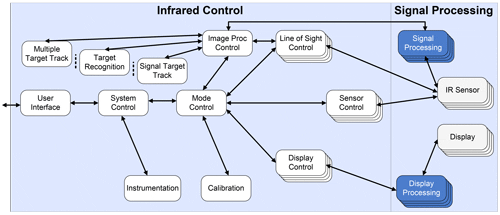
Multi-core Reduces System Development and Verification Time
Multi-core CPUs are an optimal control solution for complex modern day sensor systems. Their multiple cores are ideal for hosting the variety of control processes required in building advanced imaging, radar, and other architectures. Curtiss-Wright’s 3U VPX CHAMP-XD1 is one example of a multi-core product that provides high performance with reduced SWaP for these types of systems.
Advanced sensor systems often include multiple sensors and advanced applications that require a framework of multiple processes to control. As the functionality and performance of these systems has increased, so has the complexity of their software control. For an example, image processing application may require multiple software executables within its system architecture built from hundreds of thousands of source lines of code. Control processes for such a system framework may include:
|
|

Software-driven sensor systems have increased their capabilities with higher frame rates, reduced latencies, more complex algorithms, and additional functionality. Improvements in high-speed interfaces, FPGA, graphic, and other technologies have advanced corresponding sensor signal processing capabilities. The challenge is what can be done for the control processing of these complex systems.
The embedded multi-core processor is a game changer for both advanced sensor signal processing and for the control side as well; both in terms of reducing the SWaP footprint and simplifying software development and/or verification. Past sensor processing systems were custom-built for each program. With advanced open system architectures, high performance solutions could then be designed by mixing and matching modules in standard VME and OpenVPX backplanes. With multi-cores available in processors like the CHAMP-XD1, sensor processing architects can now intelligently mix and match cores for different control processing tasks minimizing hardware and software modifications by using a common software framework to reduce development time and the corresponding product schedule, cost, and risk.
Download the Intel Xeon Cores Power High Performance and Low SWaP Complex Sensor Systems White Paper to learn more.